William Nicoll House - Digital Archive
The Digital Archive and complementary Interactive Heritage Register Map are initiatives to provide historical information regarding properties included on the Township’s Heritage Register. The Digital Archive only includes properties which have consented to include their heritage property on this archive.
The lands we know today as the Township of Puslinch have been home to
Indigenous peoples since time immemorial. We acknowledge that we are on the
traditional territory of the Hatiwendaronk, as well as the treaty lands and traditional
territory of the Anishinaabe and Haudenosaunee.
With increasing encroachment by non-Indigenous settlers in the Township of Puslinch, the Anishinaabe and Haudenosaunee could not continue their traditional lifestyle and settled in their villages along the Credit River and in the Grand River Valley. These Indigenous nations uphold their Treaty Rights within our jurisdiction.
Today, the Township of Puslinch remains home to Indigenous peoples from across Turtle Island. We are grateful to have the opportunity to share and respect Mother Earth and are committed to building constructive and cooperative relationships with Indigenous nations.
William Nicoll House

Biographical Info
The William Nicoll House was built around 1860 to 1880. Alexander Nicoll constructed a log house on the site, which he later incorporated into the current stone house. The one-storey structure built in 1860 had a second storey added in 1880. The Nicoll House possesses unique chimneys, soffits, and rusticated quoins, and is an excellent example of a complete homestead.
Andrew Stahl had purchased Lot 35 in the 1830s. Stahl sold the property to Alexander Nicoll in 1834. After Alexander’s death, his son, Lieutenant Colonel William Nicoll took over the property at age fifteen. William Nicoll held many municipal offices, including Reeve of Puslinch (1882-1893) and Warden of Wellington County. He was a highly respected member of the Puslinch community.
The William Nicoll House is associated with Scottish immigration, as well as political and military history in Puslinch.










